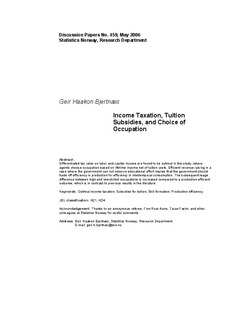| dc.contributor.author | Bjertnæs, Geir Haakon | |
| dc.date.accessioned | 2011-11-19T20:55:46Z | |
| dc.date.available | 2011-11-19T20:55:46Z | |
| dc.date.issued | 2006 | |
| dc.identifier.issn | 1892-753x | |
| dc.identifier.uri | http://hdl.handle.net/11250/180705 | |
| dc.description.abstract | Abstract:
Differentiated tax rates on labor and capital income are found to be optimal in this study, where
agents choose occupation based on lifetime income net of tuition costs. Efficient revenue raising in a
case where the government can not observe educational effort implies that the government should
trade off efficiency in production for efficiency in intertemporal consumption. The subsequent wage
difference between high and low-skilled occupations is increased compared to a production efficient
outcome, which is in contrast to previous results in the literature.
Keywords: Optimal income taxation; Subsidies for tuition; Skill formation; Production efficiency | no_NO |
| dc.language.iso | eng | no_NO |
| dc.publisher | Statistics Norway, Research Department | no_NO |
| dc.relation.ispartofseries | Discussion Papers;No. 459 | |
| dc.subject | Income taxation | no_NO |
| dc.subject | Skill formation | no_NO |
| dc.subject | Production efficiency | no_NO |
| dc.subject | JEL classification: H21 | no_NO |
| dc.subject | JEL classification: H24 | no_NO |
| dc.title | Income taxation, tuition subsidies, and choice of occupation | no_NO |
| dc.type | Working paper | no_NO |
| dc.subject.nsi | VDP::Social science: 200::Economics: 210::Economics: 212 | no_NO |
| dc.source.pagenumber | 31 s. | no_NO |
